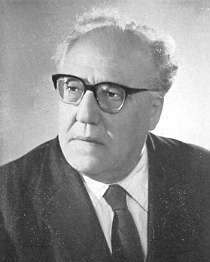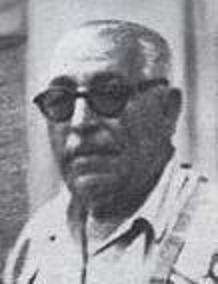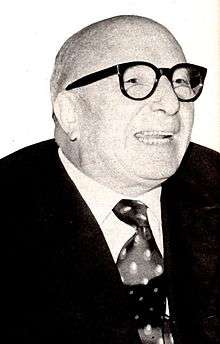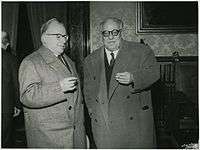Girolamo Li Causi
| Girolamo Li Causi | |
|---|---|
 | |
| Member of the Italian Chamber of Deputies | |
|
In office 1946–1968 | |
| Constituency | Sicily |
| Personal details | |
| Born |
January 1, 1896 Termini Imerese, Italy |
| Died |
April 14, 1977 (aged 81) Rome, Italy |
| Political party | Italian Communist Party |
Girolamo Li Causi (January 1, 1896 – April 14, 1977) was an Italian politician and a leader of the Italian Communist Party (Partito Comunista Italiano, PCI). He was actively involved in the post war struggle for land reform and against the Mafia in Sicily. He labelled the large estate (the latifondo) Sicily's central problem.[1]
Political activist
Li Causi was born in Termini Imerese, a town in the province of Palermo on the northern coast of Sicily. The son of a shoemaker, he graduated with an economics degree from the University of Venice in northern Italy. As a student he joined the Italian Socialist Party (Partito Socialista Italiano, PSI).[2]
Forced to leave Venice by the Fascists after Mussolini’s March on Rome in October 1922, he went to Rome and then Milan, where he helped organise the Third Internationalist’ faction of the PSI. In the summer of 1924 he adhered to the Italian Communist Party (Partito Comunista Italiano, PCI). He was part of the editorial staff of the Communist newspaper l'Unità and the magazine Pagine rosse.[2][3] After the failed assassination attempt on the fascist prime minister Benito Mussolini in September 1926, the PCI was outlawed and the publication of l'Unità suppressed. A clandestine edition resumed on the first day of 1927 in which Li Causi was actively involved.[4]
Resisting fascism
Li Causi became the PCI interregional secretary in Piedmont and Liguria, where he succeeded in producing clandestine copies of L’Unità and in helping organise rice workers’ strikes in Piedmont. He fled to Paris in mid-1927, but was arrested on May 10, 1928 in Pisa, during one of his clandestine return trips. Li Causi was sentenced to 20 years and nine months in prison. In 1937, as the result of a political amnesty, he was released from prison and banished to the penal colony on the island of Ponza. When Mussolini was forced to resign on July 25, 1943, Li Causi stayed in the penal colony on the island of Ventotene, 40 kilometres to the east of Ponza.[2][3]
After his release, he went north to join the resistance against the German occupation and remaining Italian fascists.[5] He was the PCI representative on the National Liberation Committee for Upper Italy in Milan, active in producing L’Unità clandestinely and in organising the resistance. Li Causi became a member of the national directorate of the PCI that was reinstated on August 29, 1943, in Rome.[2][6]
Back to Sicily
The PCI directorate sent Li Causi to Sicily reinforce the party with an experienced leader. He arrived in Palermo on August 10, 1944.[7] Although the PCI – traditionally weak in Sicily – included a separatist faction, Li Causi led the Communists to a strong anti-separatist stance, and by late 1944, Communists and separatists were doing battle in the streets.[8]
Li Causi’s arrival in Sicily marked a change in Communist fortunes on the island. He worked to curb dissension, prevent violence, and block Sicilian separatism, while supporting autonomy. Li Causi believed that Sicilians would benefit from autonomy. Separatism, which represented a "vague sentimental attitude" that the island’s reactionaries supported, would only cause harm. Li Causi became the main rival of separatist leader Finocchiaro Aprile and the most consistent enemy of separatism.[1]
The Villalba attack

On September 16, 1944, Li Causi and the local socialist leader Michele Pantaleone, as leaders of the Blocco del popolo (Popular Front) in Sicily, went to speak to the landless labourers at an election rally in Villalba, challenging the Mafia boss Calogero Vizzini in his own personal fiefdom. In the morning tensions rose when Christian Democrat mayor Beniamino Farina – a relative of Vizzini as well as his successor as mayor – angered local communists by ordering all hammer-and-sickle signs erased from buildings along the road on which Li Causi would travel into town. When his supporters protested, they were intimidated by separatists and thugs.[9]
The rally began in late afternoon. Vizzini had agreed to permit the meeting and assured them there would be no trouble as long as local issues, land problems, the large estates, or the Mafia were not addressed. Both speakers who preceded Li Causi, among whom Pantaleone, followed Vizzini’s commands. Li Causi did not. He denounced the unjust exploitation by the Mafia, and when Li Causi started to talk about how the peasants were being deceived by 'a powerful leaseholder' – a thinly disguised reference to Vizzini – the Mafia boss hurled: It’s a lie. Pandemonium broke out. The rally ended in a shoot-out which left 14 people wounded including Li Causi and Pantaleone.[7][9][10][11][12]
Always the Communist ready to educate the proletariat, Li Causi hurled at one of the peasant attackers: "Why are you shooting, who are you shooting at? Can’t you see that you're shooting at yourself?"[13] (Don Calò and his bodyguard were accused of attempted manslaughter. The trial dragged on until 1958, but by 1946 the evidence had already disappeared. Vizzini was never convicted because by the time of the verdict he was already dead.[11]
Election surprise
The Villalba attack inaugurated a long series of Mafia attacks in Sicily on political activists, trade union leaders and ordinary peasants resisting Mafia rule and claiming land titles.[9] In the following years many left-wing leaders were killed or otherwise attacked. On April 20–21, 1947, the Blocco del popolo – a coalition of the communist PCI and socialist PSI – won a surprise victory in the elections for the Constituent Assembly of the autonomous region of Sicily. The Blocco obtained 29 percent of the vote, while the (Christian Democrat Party) got 20.5% and the Qualunquist-Monarchist bloc came third with 14%.
Li Causi furnished an explanation for the success of the left-wing block:
"For the Communist Party, there is no question of world revolution, but of feeding and democratising the people. We plan no Soviet here. We want the big feudal land holdings redistributed, but we respect all properties below 100 hectares [247 acres]. And that is a good-sized piece of property. We want industry... . We want to put the idle to work. Capital will find all the guarantee it needs."[14]
Portella della Ginestra massacre
.jpg)
Twelve days after the left-wing election victory, the May 1 labour parade in Portella della Ginestra was attacked, culminating in the killing of 11 people and the wounding of over thirty. The attack was attributed to the bandit and separatist leader Salvatore Giuliano, intending to capture Li Causi. Nevertheless, the Mafia was suspected of involvement in the Portella di Ginestra massacre and many other attacks on left-wing organisations and leaders. The massacre created a national scandal.[15]
The Communist-controlled Italian General Confederation of Labour called a general strike in protest against the massacre. The Minister of the Interior, the Christian Democrat Mario Scelba, reported to Parliament the next day that so far as the police could determine, the Portella della Ginestra shooting was non-political. Scelba claimed that bandits notoriously infested the valley in which it occurred.[5][15] Li Causi disagreed and charged that the Mafia had perpetrated the attack, in cahoots with the large landowners, monarchists and the rightist Uomo Qualunque Front. The debate ended in a fist fight between the left and the right. Nearly 200 deputies took part in the brawl.[15]
Denouncing the massacre
Li Causi and Scelba would be the main opponents in the aftermath of the massacre and the successive killing of the alleged perpetrator, the bandit Salvatore Giuliano, and the trial against Gaspare Pisciotta and other remaining members of Giuliano’s gang. While Scelba dismissed any political motive, Li Causi stressed the political nature of the massacre – and tried to uncover the truth. Li Causi claimed that the police inspector Ettore Messana – supposed to coordinate the prosecution of the bandits – had been in league with Giuliano and denounced Scelba for allowing Messana to remain in office. Later documents would prove the accusation.[16]
Li Causi suspected a campaign against the left and linked it with the crisis in the national government (under Prime Minister Alcide De Gasperi), which would lead to the expulsion of the communists and socialist from government, as well as to prevent the left from entering the regional government. On May 30, 1947, Giuseppe Alessi, became the first president of the Sicilian region with the support of the centre right and the same day De Gasperi announced his new centrist government, who had been in the national union governments since 1945.[17]
Challenging Giuliano

Speaking at Portella della Ginestra on the second anniversary of the massacre, Li Causi publicly called on Giuliano to name names. He received a written reply from the bandit leader: "It is only men with no shame who gives out names. Not a man who tends to take justice into his own hands; who aims to keep his reputation in society high, and who values this aim more than his own life."
Li Causi responded by reminding Giuliano that he would almost certainly be betrayed: "Don’t you understand that Scelba will have you killed." Giuliano again replied, hinting at the powerful secrets that he possessed: "I know that Scelba wants to have me killed; he wants to have me killed because I keep a nightmare hanging over him. I can make sure he is brought to account for actions that, if revealed, would destroy his political career and end his life."[18][19]
At the trial for the Portella della Ginestra massacre, Gaspare Pisciotta said: "Those who have made promises to us are called Bernardo Mattarella, Prince Alliata, the monarchist MP Marchesano and also Signor Scelba, Minister for Home Affairs … it was Marchesano, Prince Alliata and Bernardo Mattarella who ordered the massacre of Portella di Ginestra. Before the massacre they met Giuliano…" However the MPs Mattarella, Alliata and Marchesano were declared innocent by the Court of Appeal of Palermo, at a trial which dealt with their alleged role in the event.[16][20]
In Parliament

Li Causi was a member of the Italian Constituent Assembly in 1946 and a Senator from 1948–53 and 1968–74, as well as national deputy in 1953-68 and vice-president of the Italian Chamber of Deputies in 1958-63. While in Parliament he was largely responsible for setting up a parliamentary commission of enquiry into the Mafia, and was vice-president of the Antimafia Commission from 1963-1972.
In an interview in the 1970s he said about the changes in the Mafia:
“… the Mafia has changed; the old sources of wealth, the rackets of cattle-stealing, water control are no longer so lucrative. Real-estate speculation, banks, the trading of jobs and collusion with the power of the State: these are the Mafia’s new fields. The Mafia goes where the power is, that is why the Christian Democrat party is riddled with it, not only on the regional level. The high protectors, the ones elected through the power of the Mafia, are in Rome.”[21]
Although a prominent Communist leader, his career was thwarted by Palmiro Togliatti, the leader of the PCI. Togliatti underestimated the problem of the Mafia, or rather, ignored it. He also did not want to antogonize the Christian Democrats, looking for a historic compromise. Togliatti preferred to avoid that Sicily became a source of irreparable confrontation between the Communists and Christian Democrats, whose Sicilian notables were sometimes contiguous to the Mafia, and some of whom also had responsibilities on a national scale. Togliatti did not hesitate to replace Li Causi as regional secretary of the Party in the late 1950s, at a time in which Mafia rule increased not only in rural areas but also in cities, starting from Palermo.[22]
Li Causi remained an important parliamentary leader at the national level. He died in Rome on April 14, 1977. A year before he died he typically fought his last legal battle. He denounced the responsibility of Giovanni Gioia – at the time the regional secretary of the Christian Democrats in Sicily – in the murder of Pasquale Almerico, the young secretary of the DC in Camporeale who had opposed the entrance of Mafia boss Vanni Sacco in the DC. He also accused another Christian Democrat politician, Vito Ciancimino, of being the center of a web of business and Mafia in Palermo administered by the DC. He was sued for libel by both. He showed up in court. He spoke at length and was acquitted in both cases.[22]
An opponent to private property by ideological conviction, senator Girolamo Li Causi never owned a house.
Speeches and books
- (Italian) Intervento di Girolamo Li Causi alla Assemblea Costituente, seduta del 15 luglio 1947
- (Italian) Intervento alla camera dei deputati at the Wayback Machine (archived June 11, 2008) di Girolamo Li Causi, seduta del 26 ottobre 1951
- (Italian) Li Causi, Girolamo (1974). Il Lungo cammino: autobiografia 1906-1944, Rome: Editori Riuniti
- (Italian) Li Causi, Girolamo (2007). Portella della Ginestra. La ricerca della verità , Ediesse, ISBN 88-230-1201-5
References
- 1 2 Finkelstein, Separatism, the Allies and the Mafia, p. 74
- 1 2 3 4 Lane, Biographical Dictionary of European Labor Leaders, p. 571
- 1 2 (Italian) Biografie Assamblea costituente
- ↑ (Italian) L’Unità, storia di un quotidiano antifascista
- 1 2 (Italian) Li Causi, l’uomo che denunciò al mondo Portella, Liberazione, May 1, 2007
- ↑ (Italian) I Centenari CGIL
- 1 2 (Italian) Il «battesimo del fuoco» di Li Causi, La Sicilia, June 24, 2007
- ↑ Review of: Separatism, the Allies and the Mafia: The Struggle for Sicilian Independence, 1943- 1948 at the Wayback Machine (archived January 31, 2007) in The Italian American Review, Volume 7, Number 1 (Spring/Summer 1999)
- 1 2 3 Finkelstein, Separatism, the Allies and the Mafia, p. 95-97
- ↑ (Italian) L'attentato di Villalba at the Wayback Machine (archived March 19, 2009), preface of Carlo Levi in Michele Pantaleone, Mafia e politica 1943-1962, Turin: Einaudi, 1962)
- 1 2 Servadio, Mafioso, p. 99
- ↑ Dickie, Cosa Nostra, p. 245-48
- ↑ Lupo, History of the Mafia, p. 190
- ↑ Caesar with Palm Branch at the Wayback Machine (archived February 3, 2011), Time Magazine, May 5, 1947
- 1 2 3 Battle of the Inkpots at the Wayback Machine (archived February 3, 2011), Time, May 12, 1947
- 1 2 Servadio, Mafioso, p. 128-29
- ↑ (Italian) Santino, La strage di Portella, la democrazia bloccata e il doppio stato
- ↑ Dickie, Cosa Nostra, p. 265-66
- ↑ (Italian) Lettera di Giuliano a "La Voce di Sicilia", 31 agosto 1947, e commento-risposta di Girolamo Li Causi at the Wayback Machine (archived June 11, 2008)
- ↑ (Italian) Mario Scelba: padre della Repubblica o regista di trame? at the Wayback Machine (archived June 21, 2008) at Giuliano e lo Stato, an Italian language site about Giuliano and the Portella della Ginestra massacre.
- ↑ Servadio, Mafioso, p. 211
- 1 2 (Italian) Valeva la pena di conoscerli. Girolamo Li Causi, Notizie radicali, January 12, 2010
Sources
- Dickie, John (2004). Cosa Nostra. A history of the Sicilian Mafia, London: Coronet ISBN 0-340-82435-2
- Finkelstein, Monte S. (1998). Separatism, the Allies and the Mafia: The Struggle for Sicilian Independence, 1943-1948, Bethlehem: Lehigh University Press ISBN 0-934223-51-3
- Lane, A. Thomas (1995). Biographical Dictionary of European Labor Leaders, London/Westport (Connecticut): Greenwood Press ISBN 0-313-26456-2
- Lupo, Salvatore (2009). History of the Mafia, New York: Columbia University Press, ISBN 978-0-231-13134-6
- (Italian) Santino, Umberto (1997). La strage di Portella, la democrazia bloccata e il doppio stato, Centro Siciliano di Documentazione "Giuseppe Impastato", April 1997
- Servadio, Gaia (1976), Mafioso. A history of the Mafia from its origins to the present day, London: Secker & Warburg ISBN 0-436-44700-2
External links
- (Italian) Girolamo Li Causi, Portale storico della Camera dei deputati
- (Italian) Giuliano e lo Stato: materiali sul primo intrigo della Repubblica at the Wayback Machine (archived June 11, 2008) an Italian language site about Giuliano and the Portella della Ginestra massacre.